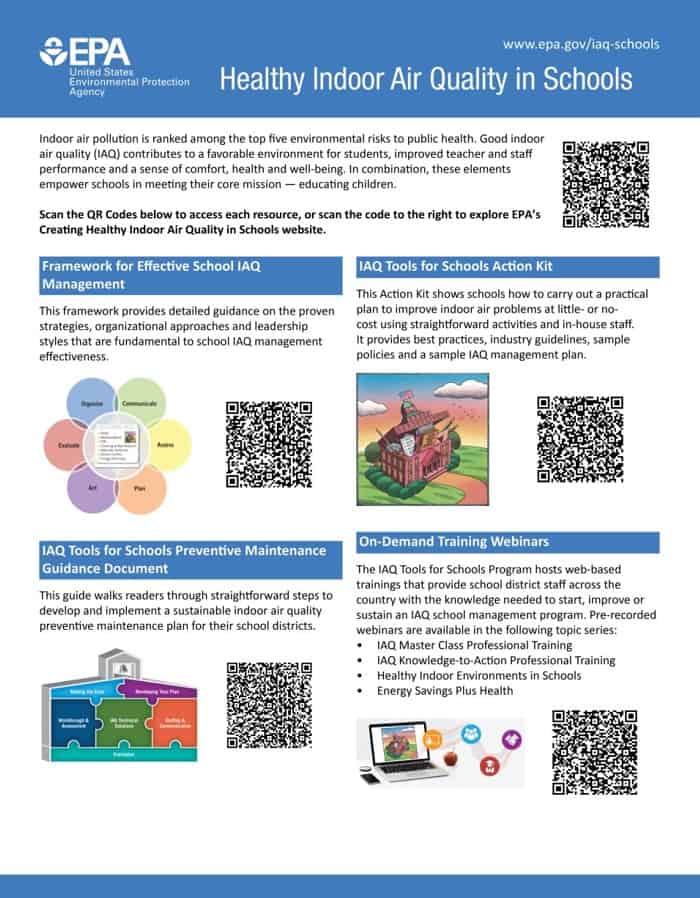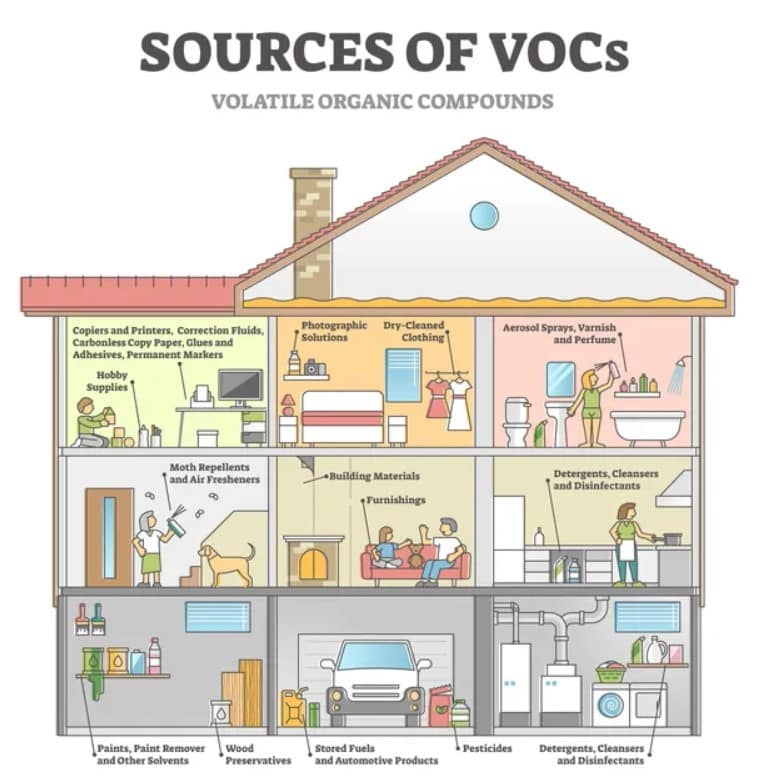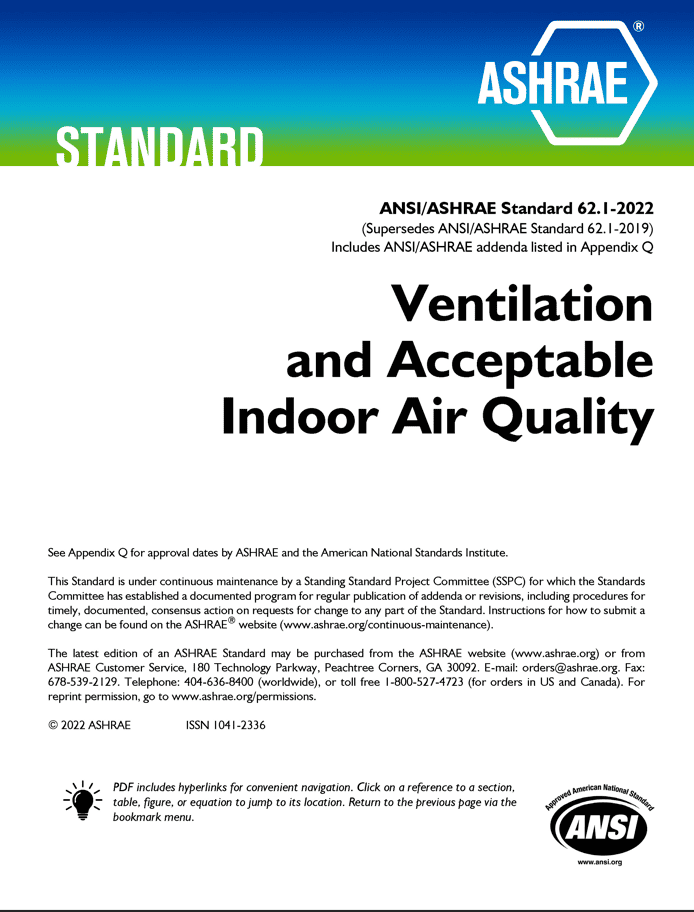Maintaining good indoor air quality (IAQ) is essential for ensuring the health, comfort, and productivity of occupants in commercial buildings.
Indoor air quality monitoring plays a crucial role in assessing and managing IAQ, helping building owners and managers comply with legal requirements and standards.
Legal Framework for Indoor Air Quality Monitoring:
Occupational Safety and Health Administration (OSHA) Regulations:
The Occupational Safety and Health Administration (OSHA) is the primary regulatory agency responsible for setting and enforcing workplace safety standards in the United States.
is the primary regulatory agency responsible for setting and enforcing workplace safety standards in the United States.
While OSHA does not have specific regulations dedicated solely to indoor air quality, several OSHA standards address aspects of indoor air quality, including ventilation, hazardous chemicals, and respiratory protection.
Some of the key OSHA standards relevant to indoor air quality include:
Ventilation Standards (29 CFR 1910.94): OSHA’s ventilation standards require employers to provide adequate ventilation in indoor workplaces to maintain air quality and prevent the accumulation of airborne contaminants.
Ventilation systems must be properly designed, operated, and maintained to ensure effective air exchange and removal of pollutants.
Hazard Communication Standard (29 CFR 1910.1200): The Hazard Communication Standard , also known as the “Right to Know” standard, requires employers to inform employees about the hazards of chemicals present in the workplace, including those that may affect indoor air quality.
, also known as the “Right to Know” standard, requires employers to inform employees about the hazards of chemicals present in the workplace, including those that may affect indoor air quality.
Employers must develop and implement a comprehensive hazard communication program that includes labeling, safety data sheets (SDS), and employee training on chemical hazards.
Respiratory Protection Standard (29 CFR 1910.134): OSHA’s Respiratory Protection Standard mandates employers to establish a respiratory protection program when workers are exposed to harmful airborne contaminants that cannot be adequately controlled through engineering controls (such as ventilation).
mandates employers to establish a respiratory protection program when workers are exposed to harmful airborne contaminants that cannot be adequately controlled through engineering controls (such as ventilation).
The standard outlines requirements for respirator selection, fit testing, training, and medical evaluations to ensure workers’ respiratory health and safety.
Confined Spaces Standard (29 CFR 1910.146): OSHA’s Confined Spaces Standard addresses the hazards associated with working in confined spaces, which may have limited ventilation and pose risks of exposure to harmful gases, vapors, and other airborne contaminants.
addresses the hazards associated with working in confined spaces, which may have limited ventilation and pose risks of exposure to harmful gases, vapors, and other airborne contaminants.
The standard requires employers to implement measures to control atmospheric hazards, including monitoring air quality and providing appropriate respiratory protection.
General Duty Clause (29 USC 654(a)(1)): OSHA’s General Duty Clause imposes a general obligation on employers to provide a workplace free from recognized hazards that are likely to cause death or serious physical harm to employees.
imposes a general obligation on employers to provide a workplace free from recognized hazards that are likely to cause death or serious physical harm to employees.
This clause may apply to indoor air quality hazards not specifically addressed by OSHA standards, emphasizing the employer’s responsibility to address known risks to workers’ health and safety.
While OSHA does not have specific regulations solely dedicated to indoor air quality, compliance with these standards helps employers mitigate indoor air quality hazards and protect workers from exposure to harmful airborne contaminants in the workplace.
Employers are encouraged to conduct regular assessments of indoor air quality, implement appropriate control measures, and provide necessary training and personal protective equipment to ensure a safe and healthy work environment.

American Society of Heating, Refrigerating, and Air-Conditioning Engineers (ASHRAE) Standards:
The American Society of Heating, Refrigerating, and Air-Conditioning Engineers (ASHRAE) is a leading organization that develops standards and guidelines for the HVAC (heating, ventilation, and air conditioning) industry.
is a leading organization that develops standards and guidelines for the HVAC (heating, ventilation, and air conditioning) industry.
ASHRAE Standard 62.1 , Ventilation for Acceptable Indoor Air Quality, provides guidance on ventilation rates and indoor air quality parameters for commercial buildings.
, Ventilation for Acceptable Indoor Air Quality, provides guidance on ventilation rates and indoor air quality parameters for commercial buildings.
Here are some key aspects of ASHRAE Standard 62.1:
Ventilation Rates: The standard specifies minimum ventilation rates and requirements for various spaces within commercial buildings, including offices, classrooms, retail spaces, and healthcare facilities.
These ventilation rates are intended to ensure adequate air exchange and maintain acceptable indoor air quality levels.
Contaminant Control: ASHRAE 62.1 addresses the control of indoor air contaminants by specifying ventilation requirements based on occupancy, occupancy density, and pollutant generation rates.
The standard aims to minimize the accumulation of airborne pollutants, such as carbon dioxide (CO2), volatile organic compounds (VOCs), and odors, to maintain a healthy and comfortable indoor environment.
Ventilation System Design: ASHRAE Standard 62.1 provides guidance on the design, installation, and operation of ventilation systems to ensure optimal performance and energy efficiency.
The standard outlines requirements for air distribution, outdoor air intake, filtration, and exhaust to achieve the desired indoor air quality objectives.
IAQ Monitoring and Maintenance: The standard recommends periodic monitoring of indoor air quality parameters, such as CO2 levels and ventilation effectiveness, to verify compliance with ventilation requirements and identify potential IAQ issues.
Additionally, ASHRAE 62.1 emphasizes the importance of regular maintenance and inspection of ventilation systems to ensure proper operation and performance over time.
ASHRAE Standard 62.1 serves as a valuable resource for engineers, designers, facility managers, and building operators involved in the design, construction, and operation of commercial buildings.
By following the guidelines outlined in the standard, stakeholders can create and maintain indoor environments that promote occupant health, comfort, and productivity while optimizing energy efficiency and sustainability.
Environmental Protection Agency (EPA) Guidelines:
The Environmental Protection Agency (EPA) offers guidance and resources on indoor air quality for commercial buildings through programs such as the Indoor Air Quality Tools for Schools program
offers guidance and resources on indoor air quality for commercial buildings through programs such as the Indoor Air Quality Tools for Schools program and the Indoor Air Quality Design Tools for Schools program.
and the Indoor Air Quality Design Tools for Schools program.
While these programs are primarily focused on educational facilities, the principles and recommendations can be applied to other types of commercial buildings.
Here’s an overview of some of the key initiatives and resources offered by the EPA in this regard:
Indoor Air Quality Tools for Schools (IAQ TfS) Program: The IAQ Tools for Schools program is designed to help schools identify, resolve, and prevent IAQ problems.
While the program primarily targets educational facilities, its principles and resources are applicable to various commercial buildings.
The program provides practical guidance, checklists, and resources for assessing and improving indoor air quality, addressing issues such as ventilation, moisture control, cleaning, and maintenance practices.
Indoor Air Quality Design Tools for Schools (IAQ DfS) Program: Similar to the IAQ TfS program, the IAQ Design Tools for Schools program focuses on providing guidance and resources for designing new school buildings or renovating existing ones to achieve optimal indoor air quality.
The program offers tools, technical guidance, case studies, and best practices for architects, engineers, and school officials involved in the design and construction process.
Indoor Air Quality Guidelines and Publications: The EPA publishes a variety of guidelines, fact sheets, and publications addressing various aspects of indoor air quality in commercial buildings.
These resources cover topics such as indoor air pollutants, ventilation strategies, mold prevention, radon mitigation, and IAQ management plans.
cover topics such as indoor air pollutants, ventilation strategies, mold prevention, radon mitigation, and IAQ management plans.
They serve as valuable references for building owners, facility managers, and other stakeholders seeking to improve IAQ in commercial settings.
Technical Assistance and Training: The EPA provides technical assistance, training workshops, webinars, and outreach programs to support building owners, facility managers, and IAQ professionals in addressing indoor air quality issues.
These resources aim to raise awareness, build capacity, and foster collaboration among stakeholders to promote healthy indoor environments in commercial buildings.
The EPA’s initiatives and resources play a vital role in promoting awareness, education, and action to improve indoor air quality in commercial buildings, ultimately contributing to the health, comfort, and well-being of building occupants and communities.

Local Building Codes and Regulations:
Local building codes and regulations play a crucial role in ensuring that commercial buildings meet certain standards for indoor air quality (IAQ) to protect the health and well-being of occupants.
Here’s how local building codes and regulations may impact IAQ monitoring in commercial buildings:
Ventilation Requirements: Local building codes often include specific requirements for ventilation systems to ensure adequate airflow and fresh air exchange within commercial buildings.
These requirements may dictate ventilation rates, system design, equipment specifications, and maintenance procedures to promote optimal indoor air quality.
Building owners and operators are typically required to comply with these ventilation standards and may need to conduct periodic inspections and testing to ensure ongoing compliance.
Occupancy Limits: Some local building codes establish occupancy limits or density requirements based on the size and intended use of commercial spaces.
These limits are designed to prevent overcrowding and maintain indoor air quality at acceptable levels for occupants.
Building owners and operators must ensure that occupancy limits are adhered to and may need to implement measures such as adjusting ventilation systems or installing air quality monitors to monitor indoor air quality in high-occupancy areas.
Pollution Control Measures: Local regulations may require commercial buildings to implement pollution control measures to minimize indoor air pollutants generated by activities such as cooking, cleaning, manufacturing, or chemical use.
These measures may include installing exhaust systems, using low-emission materials and products, implementing indoor air quality management plans, and conducting regular inspections and maintenance to prevent pollutant buildup.
Radon Mitigation: In areas with known radon risk, local building codes may require commercial buildings to implement radon mitigation measures to prevent radon gas from entering indoor spaces.
These measures may include radon-resistant construction techniques, radon testing, and mitigation systems such as sub-slab depressurization or ventilation.
Certification and Compliance: Local building codes may require commercial buildings to obtain certifications or demonstrate compliance with IAQ standards and regulations through inspections, testing, or documentation.
Building owners and operators may need to work with qualified professionals, such as IAQ consultants or environmental engineers, to ensure compliance with local requirements and obtain necessary certifications or permits.
Local building codes and regulations play a critical role in shaping IAQ monitoring and management practices in commercial buildings, ensuring that they provide safe, healthy, and comfortable indoor environments for occupants.
Building owners, operators, and stakeholders must stay informed about local requirements and take proactive measures to achieve and maintain compliance with IAQ standards and regulations.
Common Indoor Air Quality Parameters:
Common indoor air quality parameters include:
Particulate Matter (PM): Particulate matter consists of tiny particles suspended in the air, which can include dust, pollen, smoke, and other airborne particles .
.
PM levels are measured based on particle size, with PM2.5 (fine particles) and PM10 (coarse particles) being the most commonly monitored. High levels of PM can contribute to respiratory issues and other health problems.
Volatile Organic Compounds (VOCs): VOCs are organic chemicals that can evaporate into the air at room temperature.
They are emitted by a variety of sources such as building materials, furniture, cleaning products, and personal care items.
Exposure to high levels of VOCs can cause eye, nose, and throat irritation, as well as headaches, dizziness, and other health effects.

Carbon Dioxide (CO2): Carbon dioxide is a colorless, odorless gas that is naturally present in the air and is produced by human respiration and combustion processes.
Elevated CO2 levels indoors can indicate inadequate ventilation and may cause drowsiness, headaches, and impaired cognitive function in occupants.
Carbon Monoxide (CO): Carbon monoxide is a colorless, odorless gas produced by incomplete combustion of fossil fuels.
It is highly toxic and can cause carbon monoxide poisoning, leading to symptoms such as headache, dizziness, nausea, and, in severe cases, death.
Monitoring CO levels is crucial for detecting potential sources of combustion-related indoor air pollution.
Temperature and Humidity: Indoor temperature and humidity levels can impact occupant comfort, health, and well-being.
High humidity levels can promote mold growth and increase the risk of respiratory issues, while low humidity levels can cause dry skin, irritation, and discomfort.
Monitoring temperature and humidity helps maintain a healthy indoor environment.
Radon: Radon is a naturally occurring radioactive gas that can seep into buildings through cracks in the foundation or gaps in construction materials.
Prolonged exposure to elevated radon levels can increase the risk of lung cancer. Monitoring radon levels is essential for identifying and mitigating radon-related health risks in indoor environments.
is essential for identifying and mitigating radon-related health risks in indoor environments.
Formaldehyde: Formaldehyde is a colorless, pungent gas emitted by various building materials, furniture, and consumer products.
It can cause respiratory irritation, allergic reactions, and other health problems. Monitoring formaldehyde levels helps identify sources of indoor air pollution and minimize exposure risks.
Mold and Allergens: Mold spores, dust mites, pet dander, and other allergens can trigger allergic reactions and respiratory issues in sensitive individuals.
Monitoring mold and allergen levels helps identify indoor air quality problems and implement appropriate remediation measures.
levels helps identify indoor air quality problems and implement appropriate remediation measures.
These parameters are often monitored using indoor air quality monitors equipped with sensors that detect and measure specific pollutants and environmental conditions.
and environmental conditions.
Regular monitoring helps identify indoor air quality issues, track changes over time, and implement effective mitigation strategies to ensure a healthy indoor environment .
.
FAQs:
Are indoor air quality monitors required by law in commercial buildings?
While there are no federal laws mandating the use of indoor air quality monitors in commercial buildings, various regulations and standards address aspects of indoor air quality, including ventilation, hazardous chemicals, and workplace safety.
Building owners and managers are responsible for ensuring compliance with applicable regulations and standards to protect the health and safety of building occupants.
How often should indoor air quality be monitored in commercial buildings?
The frequency of indoor air quality monitoring in commercial buildings depends on various factors such as building size, occupancy type, ventilation rates, pollutant sources, and regulatory requirements.
Building owners and managers should establish monitoring schedules based on these factors and conduct regular inspections and assessments to ensure ongoing compliance with indoor air quality standards and guidelines.
What should building owners do if indoor air quality issues are detected?
If indoor air quality issues are detected through monitoring or inspections, building owners should take prompt action to address the root causes of the problems.
This may involve implementing measures such as improving ventilation, eliminating pollutant sources, conducting HVAC system maintenance, and providing occupant education and awareness programs.
Additionally, building owners should document corrective actions taken and monitor IAQ parameters to verify the effectiveness of mitigation efforts.
Conclusion:
Indoor air quality monitoring is a critical aspect of maintaining a safe and healthy environment in commercial buildings.
By adhering to legal requirements and standards, building owners and managers can ensure compliance with regulations and protect the health and well-being of occupants.
Regular monitoring, comprehensive assessments, and proactive management strategies are essential for addressing indoor air quality issues and promoting occupant comfort and productivity in commercial spaces.


